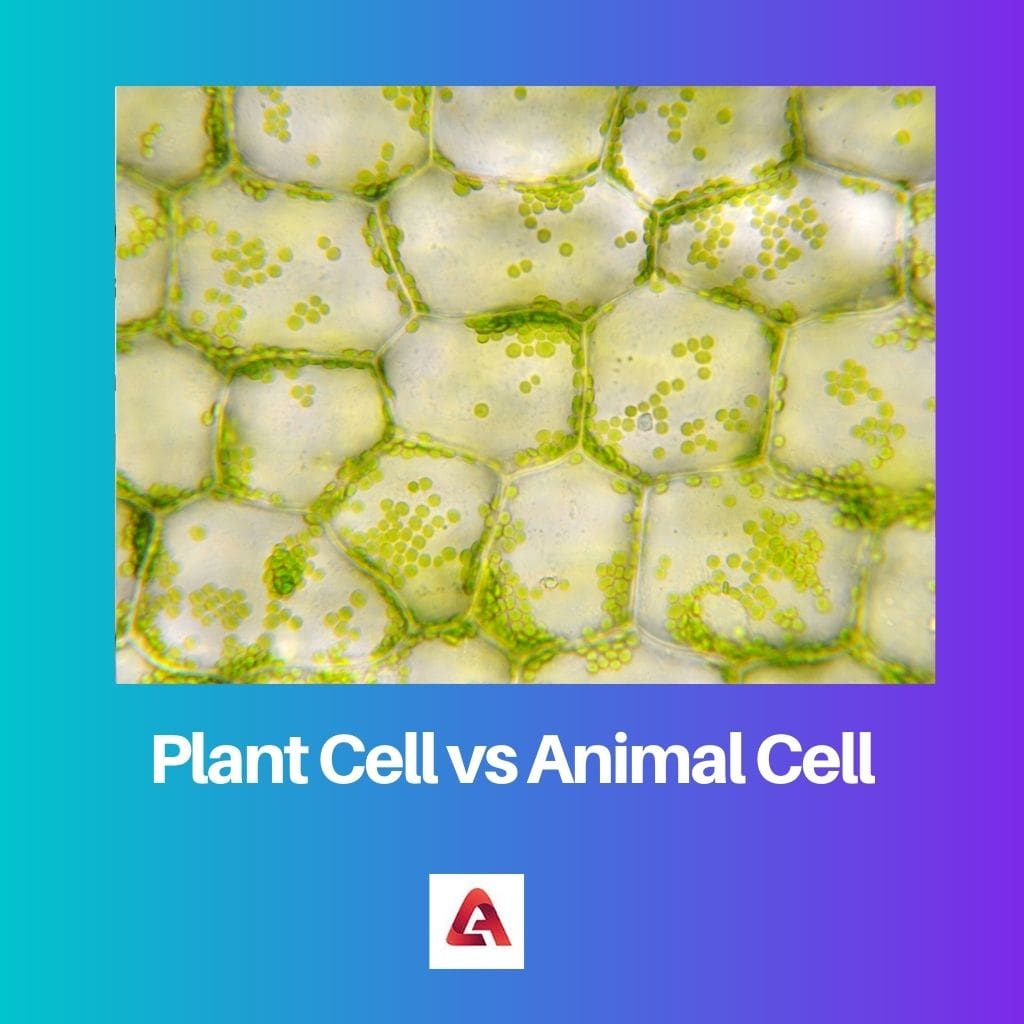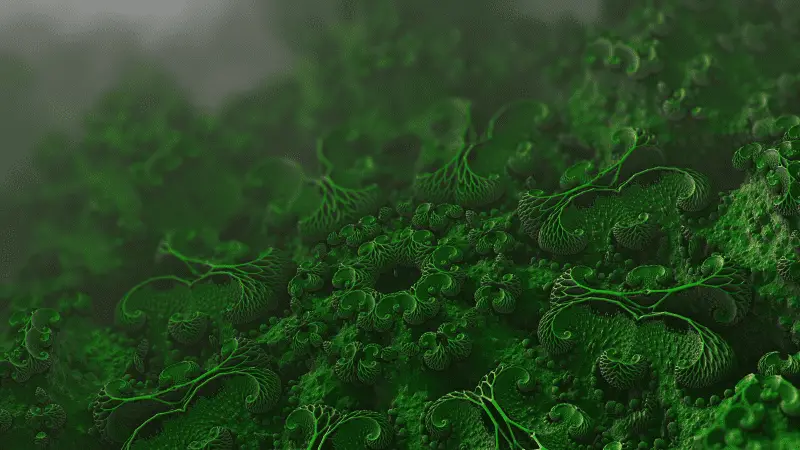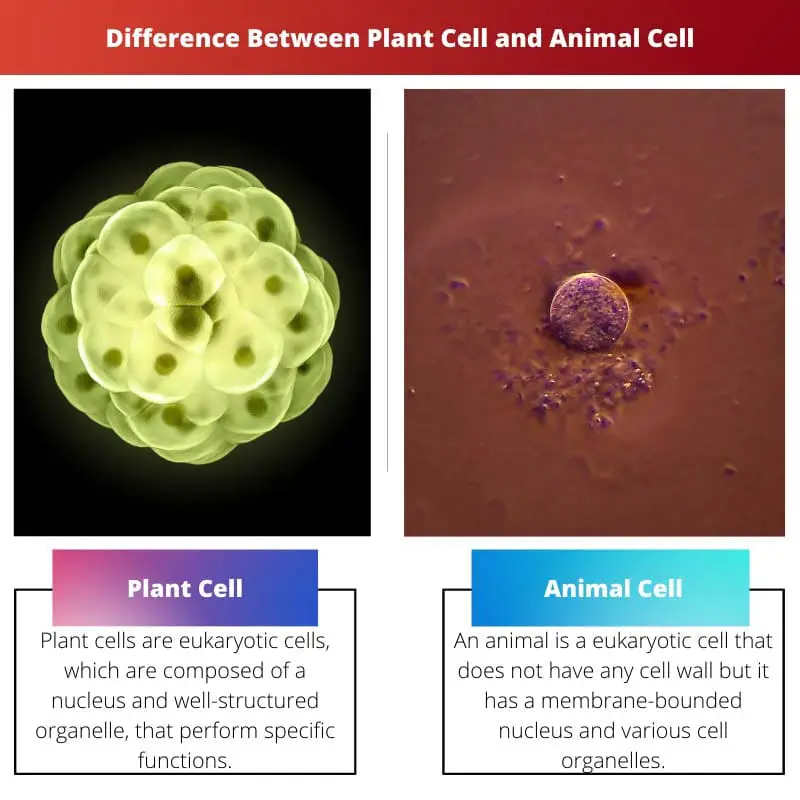Plant cells are distinguished by the presence of chloroplasts, enabling photosynthesis, and rigid cell walls composed of cellulose, providing structural support. Additionally, plant cells possess larger, centrally located vacuoles involved in maintaining turgor pressure and storing nutrients. In contrast, animal cells lack chloroplasts and cell walls but may contain centrioles aiding in cell division.
Key Takeaways
- Plant cells have a rigid cell wall made of cellulose, providing structural support, while animal cells lack this feature.
- Chloroplasts, responsible for photosynthesis, are present in plant cells but absent in animal cells.
- Plant cells have a large central vacuole for storing water and nutrients, whereas animal cells have smaller, temporary vacuoles.
Plant Cell vs Animal Cell
The difference between Plant Cells and Animal cells is their shapes. The plant cell has a rectangle or four squares in its form. Conversely, an animal cell is oblong or uncertain. Plant cells do have cell walls, but animal cells do not. The former does not contain centrosomes. On the opposite, the latter does. Cells of animals have more mitochondria, whereas plants’ cells have fewer.

Comparison Table
| Feature | Plant Cell | Animal Cell |
|---|---|---|
| Cell Wall | Present, made of cellulose | Absent |
| Chloroplasts | Present, contain chlorophyll for photosynthesis | Absent |
| Central Vacuole | Usually one large vacuole | Usually smaller and multiple vacuoles |
| Lysosomes | Rare or absent | Present |
| Centrosome | Absent | Present, helps in cell division |
| Shape | Can be rectangular, square, or irregular | More rounded or irregular |
| Shape Variability | Less variable in shape | More variable in shape |
| Size | Generally larger than animal cells | Generally smaller than plant cells |
| Movement | Generally non-motile (cannot move on their own) | Can be motile (some have flagella or cilia for movement) |
What is Plant Cell?
Structure and Function
Cell Wall
Plant cells are surrounded by a rigid cell wall primarily composed of cellulose, hemicellulose, and pectin. This structure provides mechanical support, protection against mechanical stress, and helps maintain cell shape.
Cell Membrane (Plasma Membrane)
Beneath the cell wall lies the cell membrane, a semi-permeable lipid bilayer that regulates the passage of substances in and out of the cell. It controls the exchange of nutrients, gases, and waste products between the cell and its environment.
Cytoplasm
Within the cell membrane is the cytoplasm, a gel-like substance that contains various organelles and structures essential for cellular processes. These include the cytoskeleton, which maintains cell shape and facilitates intracellular transport, and cytoplasmic streaming, which aids in the distribution of nutrients and organelles.
Nucleus
The nucleus houses the cell’s genetic material in the form of chromatin, which consists of DNA and associated proteins. It acts as the control center of the cell, regulating gene expression and directing cellular activities. The nucleus is enclosed by a double membrane known as the nuclear envelope, which contains pores that control the passage of molecules between the nucleus and cytoplasm.
Chloroplasts
One of the defining features of plant cells is the presence of chloroplasts, which are responsible for photosynthesis. Chloroplasts contain chlorophyll, a pigment that captures light energy, converting it into chemical energy in the form of glucose. This process fuels the cell and produces oxygen as a byproduct, crucial for life on Earth.
Vacuole
Plant cells typically have a large central vacuole, surrounded by a membrane called the tonoplast. The vacuole plays a vital role in maintaining turgor pressure, storing water, ions, and nutrients, and regulating cellular processes. It also serves as a storage site for waste products and toxic compounds.
Endoplasmic Reticulum (ER)
The endoplasmic reticulum is a network of membrane-bound tubules and sacs involved in protein and lipid synthesis, as well as the transport of molecules within the cell. In plant cells, there are two types of ER: rough ER, studded with ribosomes involved in protein synthesis, and smooth ER, which lacks ribosomes and is involved in lipid metabolism and detoxification.
Golgi Apparatus
The Golgi apparatus consists of flattened membranous sacs called cisternae and is responsible for processing, packaging, and sorting proteins and lipids synthesized in the ER. It modifies these molecules and directs them to their final destinations within the cell or for secretion outside the cell.
Mitochondria
Mitochondria are membrane-bound organelles responsible for cellular respiration, where glucose is oxidized to produce ATP (adenosine triphosphate), the cell’s primary energy currency. While plant cells primarily generate energy through photosynthesis, mitochondria are still essential for processes like oxidative phosphorylation and the citric acid cycle.
Peroxisomes
Peroxisomes are small, membrane-bound organelles containing enzymes involved in various metabolic processes, including the breakdown of fatty acids and the detoxification of harmful substances like hydrogen peroxide. They play a crucial role in maintaining cellular homeostasis and protecting the cell from oxidative damage.

What is Animal Cell?
Structure and Function
Cell Membrane (Plasma Membrane)
The cell membrane encloses the animal cell, serving as a selectively permeable barrier that controls the passage of molecules in and out of the cell. It is composed of a phospholipid bilayer embedded with proteins, enabling communication with the external environment and maintaining cell integrity.
Cytoplasm
The cytoplasm fills the interior of the cell and is composed of cytosol, organelles, and various cellular structures. It facilitates intracellular transport, provides structural support, and serves as the site for numerous biochemical reactions essential for cellular function.
Nucleus
The nucleus houses the cell’s genetic material, organized as chromatin consisting of DNA and associated proteins. It is enclosed by the nuclear envelope, a double membrane with nuclear pores that regulate the passage of molecules between the nucleus and cytoplasm. The nucleus controls gene expression and coordinates cellular activities through the synthesis of messenger RNA (mRNA) and ribosomal RNA (rRNA).
Mitochondria
Mitochondria are membrane-bound organelles responsible for cellular respiration, converting nutrients into ATP (adenosine triphosphate), the cell’s primary energy source. They contain their own DNA and ribosomes, allowing them to replicate independently and produce proteins necessary for their function.
Endoplasmic Reticulum (ER)
The endoplasmic reticulum is a network of membranous tubules and sacs involved in protein and lipid synthesis, as well as the transport of molecules within the cell. Rough ER, studded with ribosomes, synthesizes proteins destined for secretion or incorporation into the cell membrane, while smooth ER lacks ribosomes and is involved in lipid metabolism and detoxification.
Golgi Apparatus
The Golgi apparatus consists of flattened membranous sacs called cisternae and is responsible for processing, packaging, and sorting proteins and lipids synthesized in the ER. It modifies these molecules by adding sugars or phosphate groups and directs them to their final destinations within the cell or for secretion outside the cell.
Lysosomes
Lysosomes are membrane-bound vesicles containing digestive enzymes involved in breaking down macromolecules such as proteins, lipids, carbohydrates, and nucleic acids. They play a crucial role in cellular waste disposal, recycling damaged organelles, and programmed cell death (apoptosis).
Centrioles
Animal cells typically contain centrioles, cylindrical structures composed of microtubules, located near the nucleus. During cell division, centrioles organize the spindle fibers, essential for chromosome movement and cell separation.
Vacuoles
Animal cells may contain small, membrane-bound vacuoles involved in various functions such as storage of nutrients, waste management, and maintaining cell volume and pH. Unlike plant cells, animal cells lack a large central vacuole.
Cytoskeleton
The cytoskeleton is a dynamic network of protein filaments including microtubules, microfilaments, and intermediate filaments, providing structural support, facilitating intracellular transport, and mediating cell movement and shape changes.

Main Differences Between Plant Cell and Animal Cell
- Cell Wall:
- Plant cells have a rigid cell wall made of cellulose, providing structural support and protection.
- Animal cells lack a cell wall; their structure is maintained solely by the cell membrane.
- Chloroplasts:
- Plant cells contain chloroplasts, which perform photosynthesis, converting light energy into chemical energy.
- Animal cells do not contain chloroplasts; they rely on external food sources for energy.
- Vacuoles:
- Plant cells typically have a large central vacuole, responsible for maintaining turgor pressure and storing nutrients and waste.
- Animal cells have smaller and often multiple vacuoles, involved in various functions like storage and waste management.
- Shape:
- Plant cells are often rectangular or box-shaped due to the presence of a rigid cell wall.
- Animal cells are generally round or irregularly shaped, with a flexible cell membrane allowing for various cell shapes.
- Centrioles:
- Animal cells typically contain centrioles, which aid in cell division by organizing spindle fibers.
- Plant cells lack centrioles, although they can still undergo cell division through other mechanisms.
- Storage of Starch and Glycogen:
- Plant cells store excess carbohydrates in the form of starch, primarily in plastids like chloroplasts.
- Animal cells store carbohydrates as glycogen, primarily in the cytoplasm and liver.
- Response to Osmotic Pressure:
- Plant cells have a rigid cell wall that prevents bursting under hypotonic conditions, maintaining shape through turgor pressure.
- Animal cells lack a cell wall, making them prone to bursting under hypotonic conditions unless regulated by mechanisms like ion pumps.
- Flagella and Cilia:
- Animal cells may have flagella or cilia for movement or sensory purposes.
- Plant cells generally lack flagella or cilia, although some lower plant forms may possess similar structures for motility.

- https://link.springer.com/article/10.1007/s11191-006-9029-7
- https://www.nature.com/articles/nbt1027
- https://www.cabdirect.org/cabdirect/abstract/19900739666

The article effectively explains the process of photosynthesis in plant cells and its significance in producing energy. It’s a critical aspect of plant biology.
Absolutely, understanding the mechanisms of photosynthesis is crucial in appreciating the role of plant cells in the ecosystem.
The extensive comparison between plant and animal cells provides a comprehensive understanding of their unique characteristics. It’s a great read!
I totally agree. The detailed analysis of cellular disparities is both engaging and informative.
The information about the chloroplasts and central vacuoles in plant cells is particularly interesting. It highlights the unique features of plant biology.
I couldn’t agree more. The details about chloroplasts and central vacuoles are fascinating.
Absolutely, the article delves into the distinctive features of plant cells in a captivating manner.
I find the comparison of plastids and centrosomes between plant and animal cells to be particularly intriguing. It showcases the diversity in cellular components.
Absolutely, the detailed comparison adds depth to our understanding of cellular structures.
I couldn’t agree more. The article provides a thorough analysis of the variations in cellular components.
I find the information about the unique shapes of animal cells quite fascinating. It’s intriguing to learn about the diversity in cell structures.
Absolutely, the comparison table is really helpful in highlighting the distinctions between plant and animal cells.
The breakdown of the main differences between plant and animal cells is incredibly valuable. It provides a clear overview of their distinctions.
I agree, the article presents a thorough analysis of the fundamental variations in plant and animal cells.
The article does a great job of explaining the functions of different plant cells and how they contribute to the growth of plants. Very insightful!
Indeed, the details about the specialized plant cells and their functions are quite enlightening. It adds depth to the discussion.
I agree, the breakdown of the functions of various plant cells is comprehensive and valuable.
I appreciate the in-depth exploration of the functions of different organelles in both plant and animal cells. It enriches our understanding of cellular biology.
Agreed. The article provides valuable insights into the functions of cellular organelles in both plant and animal cells.
Absolutely, the detailed examination of organelles enhances our knowledge of the cellular mechanisms.
This article is a comprehensive guide to understanding the differences between plant and animal cells. It’s a treasure trove of knowledge.
This article provides valuable information about the differences between plant and animal cells, and it’s well-detailed. Great job!
I totally agree! The content is very informative and well-explained.